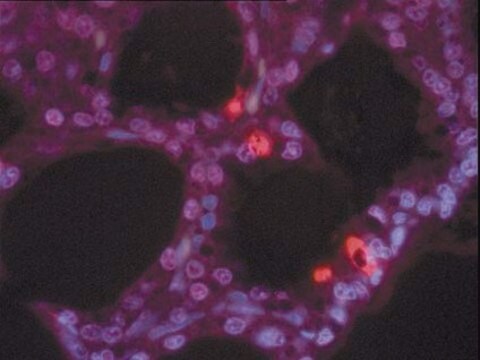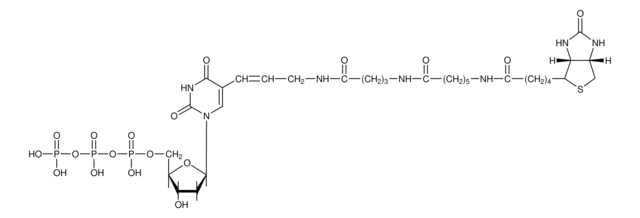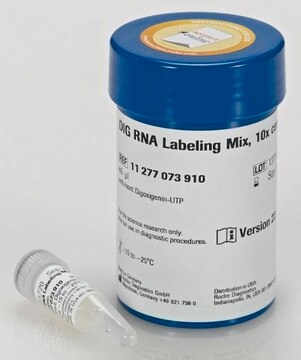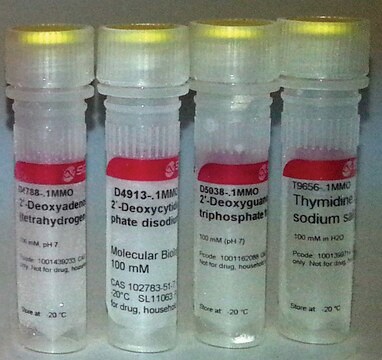RTT-RO
Roche
Terminal Transferase
from Calf Thymus, recombinant, E. coli
About This Item
Produits recommandés
Produit recombinant
expressed in E. coli
Niveau de qualité
Forme
solution
Utilisation
sufficient for 20 reactions (03333566001)
sufficient for 60 reactions (03333574001)
Conditionnement
pkg of 24,000 U (03333574001 [400 U per reaction])
pkg of 8,000 U (03333566001 [400 U per reaction])
Fabricant/nom de marque
Roche
Application(s)
genomic analysis
Température de stockage
−20°C
Description générale
Application
- Tailing with dNTPs:Addition of homopolymeric tails to DNA fragments
- Labeling of double- and single-stranded DNA and oligonucleotides with either radioactive or chemically modified nucleotides (e.g., DIG-dUTP)
Labeling of double- and single-stranded DNA and oligonucleotides with either radioactive or chemically modified dideoxynucleotides (e.g., DIG-ddUTP)
Caractéristiques et avantages
In addition to standard nucleotides, terminal transferase wlll add radioactive or modified (e.g., digoxigenin-, biotin-, or fluorochrome-labeled) dNTPs or ddNTPs to DNA.
Conditionnement
Qualité
Principe
Définition de l'unité
Unit Assay: Unit assay conditions: 200 mM Potassium cacodylate, 1 mM CoCl2, 1 mM dTTP, 0.1 OD d(pT)6, 6.25 pmol 3H dTTP in a 120 μl reaction volume.
Volume Activity: 400 U/μl
Sample Materials
- Double- or single-stranded DNA fragments
- Double- or single-stranded oligonucleotides
Notes préparatoires
Preparation of CoCl2 working solution
Add in a sterile vial 10 μl double dist. water and 15 μl of the supplied 25 mM CoCl2 solution: Final concentration: 15 mM
Preparation of radioactive labeling mix
dATP and dTTP labeling mix: mix 1 Vol. of a 2.5 mM dATP or dTTP solution with 15 volumes of double-distilled water and 4 volumes of α-32P-dATP or α-32P-dTTP (800 Ci/mmol, approx. 30 TBq/mmol).
dGTP and dCTP labeling mix: mix 1 volume of a 2 mM dGTP or dCTP solution with 15 volumes of double-distilled water and 4 volumes of α-32P-dGTP or α-32P-dCTP (800 Ci/mmol, approx. 30 TBq/mmol)
Autres remarques
Composants de kit seuls
- Terminal Transferase 400 U/μl
- TdT Reaction Buffer 5x concentrated
- CoCl<sub>2</sub> Solution 25 mM
Mention d'avertissement
Danger
Mentions de danger
Conseils de prudence
Classification des risques
Acute Tox. 4 Inhalation - Acute Tox. 4 Oral - Aquatic Chronic 2 - Carc. 1B Inhalation - Repr. 1B
Code de la classe de stockage
6.1D - Non-combustible, acute toxic Cat.3 / toxic hazardous materials or hazardous materials causing chronic effects
Classe de danger pour l'eau (WGK)
WGK 3
Point d'éclair (°F)
does not flash
Point d'éclair (°C)
does not flash
Certificats d'analyse (COA)
Recherchez un Certificats d'analyse (COA) en saisissant le numéro de lot du produit. Les numéros de lot figurent sur l'étiquette du produit après les mots "Lot" ou "Batch".
Déjà en possession de ce produit ?
Retrouvez la documentation relative aux produits que vous avez récemment achetés dans la Bibliothèque de documents.
Les clients ont également consulté
Notre équipe de scientifiques dispose d'une expérience dans tous les secteurs de la recherche, notamment en sciences de la vie, science des matériaux, synthèse chimique, chromatographie, analyse et dans de nombreux autres domaines..
Contacter notre Service technique














